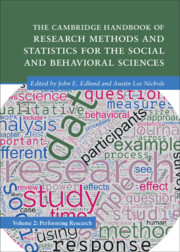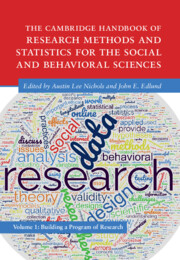53 results

The Cambridge Handbook of Research Methods and Statistics for the Social and Behavioral Sciences
- Volume 2: Performing Research
- Coming soon
-
- Expected online publication date:
- September 2024
- Print publication:
- 30 September 2024
-
- Book
- Export citation
Contributors
-
- Book:
- The Cambridge Handbook of Research Methods and Statistics for the Social and Behavioral Sciences
- Published online:
- 25 May 2023
- Print publication:
- 08 June 2023, pp xvi-xviii
-
- Chapter
- Export citation
Figures
-
- Book:
- The Cambridge Handbook of Research Methods and Statistics for the Social and Behavioral Sciences
- Published online:
- 25 May 2023
- Print publication:
- 08 June 2023, pp x-xiii
-
- Chapter
- Export citation
Part V - Tips for a Successful Research Career
-
- Book:
- The Cambridge Handbook of Research Methods and Statistics for the Social and Behavioral Sciences
- Published online:
- 25 May 2023
- Print publication:
- 08 June 2023, pp 627-816
-
- Chapter
- Export citation
Index
-
- Book:
- The Cambridge Handbook of Research Methods and Statistics for the Social and Behavioral Sciences
- Published online:
- 25 May 2023
- Print publication:
- 08 June 2023, pp 817-842
-
- Chapter
- Export citation
Contents
-
- Book:
- The Cambridge Handbook of Research Methods and Statistics for the Social and Behavioral Sciences
- Published online:
- 25 May 2023
- Print publication:
- 08 June 2023, pp vii-ix
-
- Chapter
- Export citation
Preface
-
- Book:
- The Cambridge Handbook of Research Methods and Statistics for the Social and Behavioral Sciences
- Published online:
- 25 May 2023
- Print publication:
- 08 June 2023, pp xix-xx
-
- Chapter
- Export citation
Part II - The Building Blocks of a Study
-
- Book:
- The Cambridge Handbook of Research Methods and Statistics for the Social and Behavioral Sciences
- Published online:
- 25 May 2023
- Print publication:
- 08 June 2023, pp 177-266
-
- Chapter
- Export citation
Copyright page
-
- Book:
- The Cambridge Handbook of Research Methods and Statistics for the Social and Behavioral Sciences
- Published online:
- 25 May 2023
- Print publication:
- 08 June 2023, pp iv-iv
-
- Chapter
- Export citation
Part III - Data Collection
-
- Book:
- The Cambridge Handbook of Research Methods and Statistics for the Social and Behavioral Sciences
- Published online:
- 25 May 2023
- Print publication:
- 08 June 2023, pp 267-440
-
- Chapter
- Export citation
Appendix - Syntax in lavaan for specifying and analyzing the example path model
- from 25 - Structural Equation Modeling
-
- Book:
- The Cambridge Handbook of Research Methods and Statistics for the Social and Behavioral Sciences
- Published online:
- 25 May 2023
- Print publication:
- 08 June 2023, pp 554-558
-
- Chapter
- Export citation
Tables
-
- Book:
- The Cambridge Handbook of Research Methods and Statistics for the Social and Behavioral Sciences
- Published online:
- 25 May 2023
- Print publication:
- 08 June 2023, pp xiv-xv
-
- Chapter
- Export citation
Dedication
-
- Book:
- The Cambridge Handbook of Research Methods and Statistics for the Social and Behavioral Sciences
- Published online:
- 25 May 2023
- Print publication:
- 08 June 2023, pp v-vi
-
- Chapter
- Export citation
Part IV - Statistical Approaches
-
- Book:
- The Cambridge Handbook of Research Methods and Statistics for the Social and Behavioral Sciences
- Published online:
- 25 May 2023
- Print publication:
- 08 June 2023, pp 441-626
-
- Chapter
- Export citation
Part I - From Idea to Reality: The Basics of Research
-
- Book:
- The Cambridge Handbook of Research Methods and Statistics for the Social and Behavioral Sciences
- Published online:
- 25 May 2023
- Print publication:
- 08 June 2023, pp 1-176
-
- Chapter
- Export citation

The Cambridge Handbook of Research Methods and Statistics for the Social and Behavioral Sciences
- Volume 1: Building a Program of Research
-
- Published online:
- 25 May 2023
- Print publication:
- 08 June 2023
16 - Sex Differences and Sex Similarities
- from Part II - Middle-Level Theories
-
-
- Book:
- The Cambridge Handbook of Evolutionary Perspectives on Sexual Psychology
- Published online:
- 30 June 2022
- Print publication:
- 21 July 2022, pp 360-389
-
- Chapter
- Export citation
Index
-
- Book:
- Advanced Research Methods for the Social and Behavioral Sciences
- Published online:
- 22 February 2019
- Print publication:
- 14 March 2019, pp 368-374
-
- Chapter
- Export citation
Dedication
-
- Book:
- Advanced Research Methods for the Social and Behavioral Sciences
- Published online:
- 22 February 2019
- Print publication:
- 14 March 2019, pp v-vi
-
- Chapter
- Export citation
19 - Development and Applications of Item Response Theory
- from Part Five - New Statistical Trends in the Social and Behavioral Sciences
-
- Book:
- Advanced Research Methods for the Social and Behavioral Sciences
- Published online:
- 22 February 2019
- Print publication:
- 14 March 2019, pp 309-327
-
- Chapter
- Export citation



